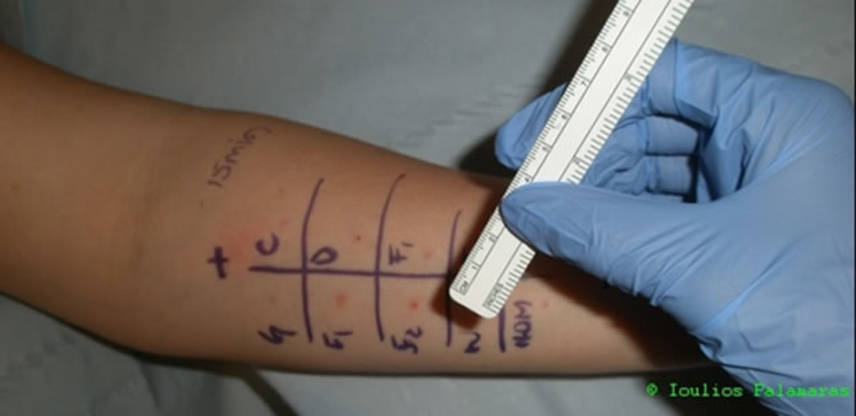Skin Prick Testing Information
This test measures specific IgE attached to cells in the skin important in allergies called "mast" cells.
Skin prick testing is usually the first test recommended when an immediate (“sudden”) type of allergy is suspected. The advantages are that it is a simple and quick form of testing, providing results within 15-20 minutes.
It can give useful information in all forms of immediate type of allergy, in particular for inhaled and/or ingested (eaten/food) allergies. The test is conducted by a specialist nurse under the direct supervision of Dr Palamaras. The skin prick test introduces a tiny amount of allergen into the skin that testing is quite safe, and almost any age group can be tested. However, where there has been a clear anaphylactic (shock) reaction to a specific allergen (e.g. after eating nuts), then skin testing may not be appropriate.
It is usually carried out on the inner forearm, but if the patient has bad eczema the test can be performed on the back.
The allergens are selected after a consultation with Dr Palamaras, and in accordance with the patient’s history. As few as 3 or 4 or up to about 25 allergens can be tested on one occasion.
What does Skin Prick Testing Involve?
Initially, the arm is coded with a marker pen for the allergens to be tested. A drop of the allergen (extract) solution is placed by each code.
The skin is then pricked through the drop using the tip of a lancet. This can feel a little uncomfortable but should not be painful. A positive reaction to an allergen causes the skin to become itchy within a few minutes and then becomes red and swollen with a "weal" in the centre (very much like the reaction to a nettle sting).
The weal has a raised edge, which slowly expands to reach its maximum size in about 15-20 minutes. The size of the weal varies with the average being 3-5 mm in diameter, and it clears for most people within an hour. The size of the weal does not indicate the severity of symptoms. The test tells us that a level of antibodies are /or are not present which may be causing your symptoms.
In skin prick test there are also included a negative and positive control.
The negative control is a saline (salt-water) solution, to which a response is not expected. If however a patient reacts to a negative control, then this will indicate that the skin is, for what ever reason, extremely sensitive and that the results need to be interpreted with the utmost care.
The positive control solution contains histamine, to which everyone is expected to react. Failure to do so could mean that medicines that the sufferer is taking could block the response to the histamine and allergens. Patients will be asked to avoid taking anti histamines, one week prior to the test and some other medicines for about 5-6 days.
A negative response to skin prick testing usually indicates that the patient is not sensitive to that allergen. False negative reactions may occur if the patient is taking anti-histamines or other medications that block the effect of histamine. Also, the skin in some elderly people may not be capable of reacting.
Finally for reasons which we do not yet fully understand, skin prick testing with food allergens is less reliable than with some other allergens such as dust and pollens, so false negative reactions can occur.

In this section:
« Patch Testing